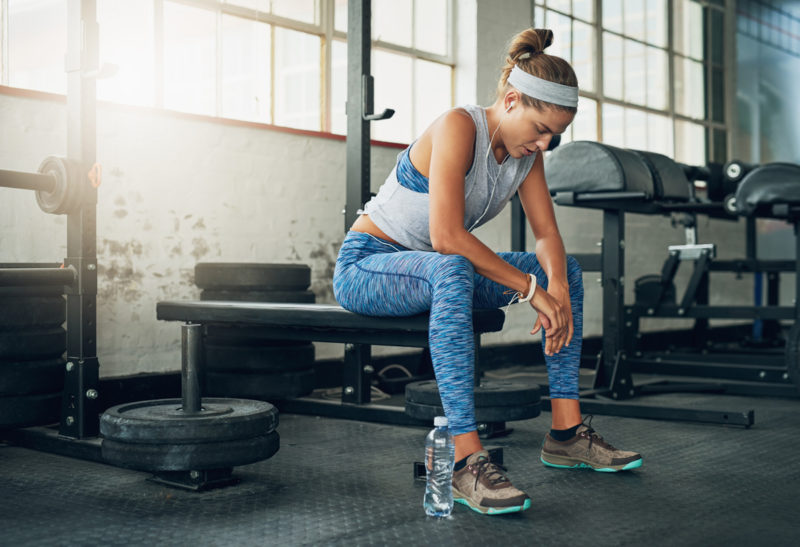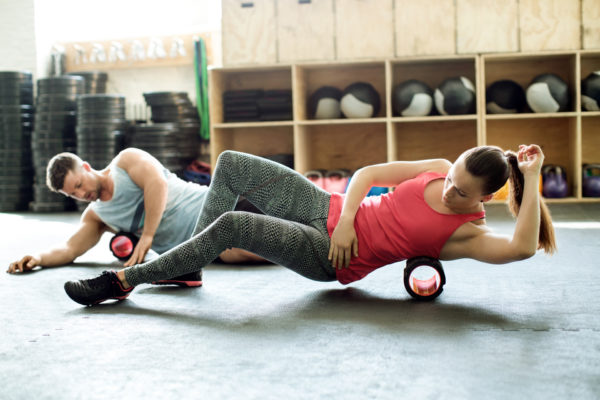When undertaking regular exercise, one of the biggest concerns is experiencing an injury that will keep you out of the gym for several days, or potentially weeks and months.
Whilst we all think we know our bodies well enough to prevent an injury, sometimes we simply push ourselves too hard or don’t look after our body well enough. It’s important to understand what we can do to better take care ourselves before, during and after our sessions to ensure we don’t do any unnecessary damage to our bodies.
Here are 10 helpful tips to prevent injuries during exercise:
1. Warm Up & Cool Down
Warming up and cooling down are critical steps in injury prevention. You don’t have to do anything too strenuous, some form of stretching (either active or static) before and after your workout should suffice. Or, you could even include some light-to-medium intensity cardio at the beginning of your session to get the blood flowing and your muscles warm.
Equally, once you finish, it’s important not to jump straight in the car or plant yourself on the couch. Spending a few minutes stretching or walking in a cool down will help reduce your heart rate and blood pressure, as well as relax the muscles that you just worked out.

2. Plan Your Sessions
Put some time into planning your workouts to ensure that you’re not overworking the same muscle groups and that you’re spreading the workload throughout your body. If you were to exercise your arms for three or four days in a row, you are subjecting yourself to injuring the muscles in your arms.
Schedule in different muscle groups throughout the week so each has time to recover before you work them again a couple of days later.
3. Rest Between Exercises
Not only should you consider resting muscle groups between sessions, but you also need to factor in how much rest you are taking between each exercise to ensure that your muscles are recovering immediately before you work them again.
Without adequate time between reps or sets, you’re increasing the potential for injury. Some easy ways to ensure you are resting between exercises are to set a timer on your phone or watch, play out an entire song, or work out with a partner and spot them in between turns.

4. Know Your Limits
After a while, we all understand our own bodies and how hard we can push them, but sometimes we go beyond our limits and this is when we can do damage.
Listen to what your body is telling you. If you’re pulling up sore after sessions, don’t go and do another workout the next day. Or, choose to work on a completely different muscle group, as previously mentioned.
It’s not just soreness or pain you should look out for, but also keep on top of your energy levels to ensure you’re not burning out. A day off won’t kill anyone. In fact, you can even turn it into a stretch or foam roll session instead, or any other form of active recovery.
5. Use Proper Technique
This is a very common cause for injuries in the gym, especially for people who are new to fitness or are trying a workout they’ve never done before.
Using an improper technique will not only lead to a lack of results for that exercise, but it can also lead to serious injury, particularly if heavy weights are involved. Take the time to learn the proper techniques for exercises such as squats (see our How To Squat blog here), deadlifts (see our Deadlift Techniques blog here) and presses, as they need to be performed properly to avoid any chance of injury.

6. Get Professional Assistance
If you don’t know how to do something, make sure to ask how. There’s usually a qualified fitness instructor roaming the floor, so don’t hesitate to call them over so they can help you do an exercise properly. They’ll usually be able to let you know if you’re not doing something right.
In fact, it’s even better to work out with a Personal Trainer one-on-one, as they’ll be able to set-up the exercises for you, watch as you complete them and correct any technique issues. Without the help of a fitness professional, you’re relying on using your own judgement, or that of your workout partner, which may not always be correct.
7. Wear The Right Gear
Although a minor element to injury prevention, wearing the right gear and equipment is still an important factor. For example, if you run on the treadmill with shoes that provide no foot support whatsoever, then the likelihood of rolling your ankle or experiencing pain in surrounding muscles and joints is increased.
Also, when lifting heavy weights, you should look into wearing protective gear such as belts, gloves and straps (making sure that they are fitted to your body) or use gym chalk for better grip of barbells and dumbbells. The investment in this gear will pay off by protecting your body and keeping you in the gym longer.
8. Recover Well
As covered in our Short Course on Optimising Recovery After Exercise, there are various methods that will help your body recover in between fitness sessions, including:

- Sleep
- Compression Garments
- Foam Rolling
- Nutrition
- Stretching
- Sports Massage
- Low-Intensity Activity
- Electrostimulation
Whilst each has their own varying effectiveness on your recovery, the point is to ensure you’re actually doing one or more of these post-workout.
Getting more sleep is one commonly-known effective recovery method and is fairly easy to achieve by going to bed earlier or setting your alarm for later.
Meanwhile, getting a sports massage may come with additional investment, but becomes worth it when it assists your recovery and helps you get back into the gym sooner rather than later.
9. Eat & Drink Adequately
One of the recovery methods we’ll elaborate more on is nutrition, as it’s a critical step to helping your body recover and sending much needed assistance to your muscles.
According to Sports Dieticians Australia, the goals of recovery nutrition are to:
- Appropriately refuel and rehydrate the body
- Promote muscle repair and growth
- Boost adaptation from the training session
- Support immune function
Without eating the right quality and quantity of food, or consuming enough liquids, you won’t be able to achieve these crucial recovery goals and will struggle when you head to the gym next. You don’t need to be stuffing your face entirely after a big workout, but just focus on consuming MORE of the RIGHT stuff.

10. Seek Medical Attention
At the end of the day, if you’re experiencing an unusual level of pain or if it just won’t go away, don’t hesitate to see a physiotherapist or your General Practitioner. Let an expert examine your body to identify any potential injuries that need to be treated in the appropriate manner.
Often we want to “push through” the pain, but we’re only doing more damage to ourselves. Listen to what the professionals tell you and make sure to follow their recommendations to prevent or overcome any injuries.
Consider these 10 tips moving forward and you’ll go a long way to preventing the likelihood of injuries during exercise.
If you have a passion for helping people achieve their fitness goals and want to ensure they don’t experience injuries whilst training, find out more info about becoming a Personal Trainer today!












